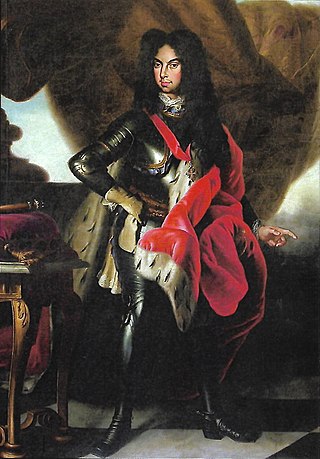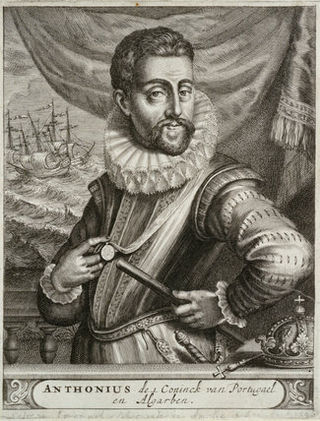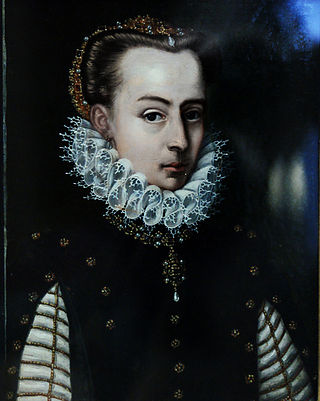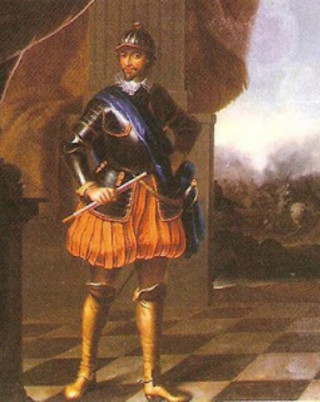
DomAfonso VI, known as "the Victorious", was the second king of Portugal of the House of Braganza from 1656 until his death. He was initially under the regency of his mother, Luisa de Guzmán, until 1662, when he removed her to a convent and took power with the help of his favourite, D. Luís de Vasconcelos e Sousa, 3rd Count of Castelo Melhor.

Manuel I, known as the Fortunate, was King of Portugal from 1495 to 1521. A member of the House of Aviz, Manuel was Duke of Beja and Viseu prior to succeeding his cousin, John II of Portugal, as monarch. Manuel ruled over a period of intensive expansion of the Portuguese Empire owing to the numerous Portuguese discoveries made during his reign. His sponsorship of Vasco da Gama led to the Portuguese discovery of the sea route to India in 1498, resulting in the creation of the Portuguese India Armadas, which guaranteed Portugal's monopoly on the spice trade. Manuel began the Portuguese colonization of the Americas and Portuguese India, and oversaw the establishment of a vast trade empire across Africa and Asia.

John II, called the Perfect Prince, was King of Portugal from 1481 until his death in 1495, and also for a brief time in 1477. He is known for reestablishing the power of the Portuguese monarchy, reinvigorating the economy of Portugal, and renewing the Portuguese exploration of Africa and Asia.

Henry, dubbed the Chaste and the Cardinal-King, was king of Portugal and an inquisitor and cardinal of the Catholic Church, who ruled Portugal between 1578 and 1580. As a clergyman, he was bound to celibacy, and as such, had no children to succeed him, and thus put an end to the reigning House of Aviz. His death led to the Portuguese succession crisis of 1580 and ultimately to the 60-year Iberian Union that saw Portugal share a monarch with Habsburg Spain. The next independent monarch of Portugal would be John IV, who restored the throne after 60 years of Spanish rule.

DomPedro II, nicknamed "the Pacific", was King of Portugal from 1683 until his death, previously serving as regent for his brother Afonso VI from 1668 until his own accession. He was the fifth and last child of John IV and Luisa de Guzmán.

DomJoseph I, known as the Reformer, was King of Portugal from 31 July 1750 until his death in 1777. Among other activities, Joseph was devoted to hunting and the opera. His government was controlled by Sebastião José de Carvalho e Melo, 1st Marquis of Pombal.

The Most Serene House of Braganza, also known as the Brigantine dynasty, is a dynasty of emperors, kings, princes, and dukes of Portuguese origin which reigned in Europe and the Americas.

Eleanor of Viseu was a Portuguese infanta (princess) and later queen consort of Portugal. She is considered one of her country's most notable queens consort and one of the only two who were not foreigners. To distinguish her from other infantas of the same name, she is commonly known as Eleanor of Viseu or Eleanor of Lancaster. In Portugal, she is known universally as Rainha Dona Leonor.

The House of Aviz, also known as the Joanine Dynasty, was a dynasty of Portuguese origin which flourished during the Renaissance and the period of the Portuguese discoveries, when Portugal expanded its power globally.

Ranuccio I Farnese reigned as Duke of Parma, Piacenza and Castro from 1592. A firm believer in absolute monarchy, Ranuccio, in 1594, centralised the administration of Parma and Piacenza, thus rescinding the nobles' hitherto vast prerogative.

The House of Farnese was an influential family in Renaissance Italy. The titles of Duke of Parma and Piacenza, Duke of Latera and Duke of Castro were held by various members of the family.

António, Prior of Crato, sometimes called "The Determined", "The Fighter", "The Independentist" or "The Resistant", was a grandson of King Manuel I of Portugal who claimed the Portuguese throne during the 1580 dynastic crisis. According to some historians, he was King of Portugal for 33 days in 1580. Philip II of Spain prevailed in the succession struggle, but António claimed the throne until 1583. He was a disciple of Bartholomew of Braga.

Infanta Catherine of Portugal, Duchess of Braganza by marriage was a Portuguese infanta (princess) claimant to the throne during the Portuguese succession crisis of 1580.

Duarte, Duke of Guimarães was a Portuguese infante (prince); the sixth son of King Manuel I of Portugal and his wife Maria of Aragon.

Luisa María Francisca de Guzmán y Sandoval was Queen of Portugal as the spouse of King John IV, the first Braganza ruler. She was the mother of two kings of Portugal and a queen of England. She served as regent of Portugal from 1656 until 1662.

Dona Maria Francisca Isabel of Savoy was Queen of Portugal during her marriage to King Dom Afonso VI from 2 August 1666 to 24 March 1668 and, as the wife of Afonso's brother King Dom Peter II, from 12 September 1683 until her death in December that year. She married Afonso VI at the age of 20; because the marriage was never consummated, she was able to obtain an annulment. On 28 March 1668, she married the King's brother Infante Dom Peter, Duke of Beja, who was appointed prince regent the same year due to Afonso's perceived incompetence. She became queen a second time when Afonso died and Peter succeeded his brother, but she herself died three months later.

Dom Fernando II of Braganza was the 3rd Duke of Braganza and the 1st Duke of Guimarães, among other titles. He is known for being executed for treason against the King.

D. Luís de Vasconcelos e Sousa, 3rd Count of Castelo Melhor was a Portuguese politician and prime minister.

The War of the Portuguese Succession, a result of the extinction of the Portuguese royal line after the Battle of Alcácer Quibir and the ensuing Portuguese succession crisis of 1580, was fought from 1580 to 1583 between the two main claimants to the Portuguese throne: António, Prior of Crato, proclaimed in several towns as King of Portugal, and his first cousin Philip II of Spain, who eventually succeeded in claiming the crown, reigning as Philip I of Portugal.

Infante Diogo of Viseu (1450–1484) was the second son of Ferdinand, Duke of Viseu, and his wife Beatriz, Duchess of Viseu.





























